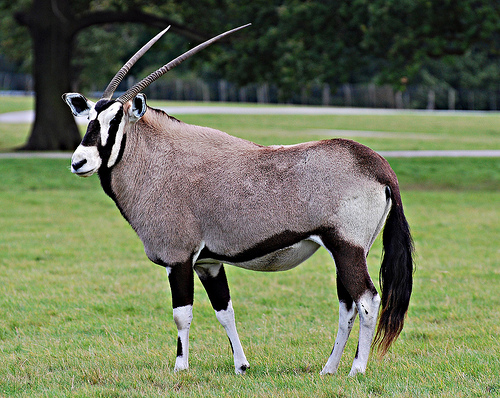
Gemsbok, orgemsbuck (Oryx gazella)
Phylum —chordata
Class — mammalia
Order — artiodactyla
Family — bovidae
Genus – oryx
Appearance
Gemsboks are light brownish-grey to tan with lighter patches toward the bottom rear of the rump. Their tails are long and black. A blackish stripe extends from the chin down the lower edge of the neck, through the juncture of the shoulder and a leg along the lower flank of each side to the blackish section of the rear leg. They have muscular necks and shoulders, and their legs have white 'socks' with a black patch on the front of both the front legs, and both genders have long, straight horns.
Gemsboks stand are 1.2 m (3.9 ft) at the shoulder. The body length can vary from 190 to 240 cm (75 to 94 in) and the tail measures 45 to 90 cm (18 to 35 in). Male Gemsbok can weigh between 180 and 240 kg (400 and 530 lb), while females weigh 100–210 kg (220–460 lb).
Habitat
It lives in the arid regions of Southern Africa, such as the Kalahari Desert.
Behavior
Gemsbok live in herds of about 10–40 animals, which consist of a dominant male, a few nondominant males, and females. They are mainly desert-dwelling and do not depend on drinking water to supply their physiological needs. They can reach running speeds of up to 60 km/h (37 mph).
Diet
The Gemsbok is generally a grazer but changes to browsing during the dry season or when grass is sparse. It may dig up to a meter deep to find roots and tubers, supplementing its water intake by eating wild tsama melons and cucumbers, which can provide all the water required (3 liters per 100 kg bodyweight and day).
Reproduction
The Gemsbok is polygynous, with one resident male mating with the receptive females in the herd. The male is known to secure exclusive mating access to the females by attempting to herd mixed or nursery herds onto his territory. The gemsbok has no specified breeding season, but the young in a given herd tend to be of a similar age due to reproductive synchrony between females.
Pregnant females leave the herd before giving birth. The gestation period lasts 270 days and mothers give birth to 1-2 offspring. The calf remains hidden 6 weeks after birth, after which mother and calf rejoin the herd. The calf is weaned at 3.5 months, becomes independent at 4.5 month, and achieves sexual maturity at 1.5–2 years in both sexes.
The average life span is approximately 18 years in the wild, and 20 in captivity.
In captivity
These animals are kept in large open areas with shelters protecting them from the wind and cold. In the enclosure there should be feeders (mangers) and drinkers.
In zoos, Gemsbok is fed with hay and fresh alfalfa grass, sliced carrots and apples, lettuce and mixed feeds. All enclosures should always contain mineral blocks and small flowing pools.
 Russian
Russian
 English
English
























